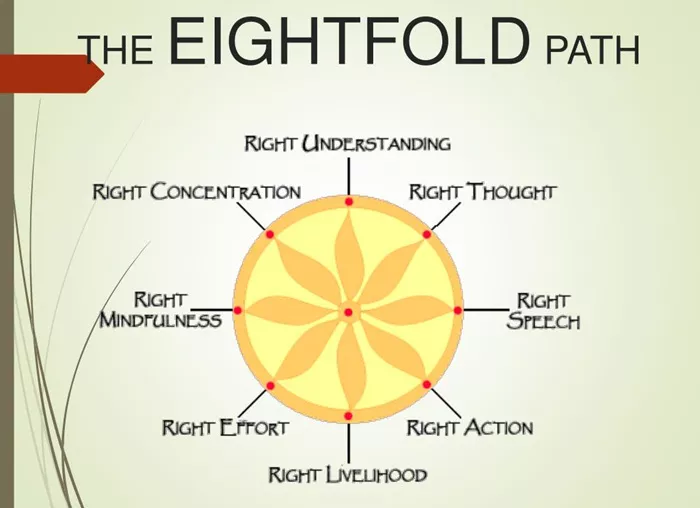The Eightfold Path is one of the core teachings in Buddhism. It is a guide to living a moral, mindful, and wise life. By following these steps, practitioners aim to achieve enlightenment and end suffering. The Eightfold Path is divided into three sections: wisdom, ethical conduct, and mental discipline. In this article, we will explore examples of each step, helping you understand how to apply them to everyday life.
1. Right Understanding (or Right View)
The first step of the Eightfold Path is “Right Understanding.” This refers to seeing the world as it truly is. It involves understanding the Four Noble Truths—the foundation of Buddhist teachings. These truths explain that life involves suffering, suffering is caused by desire, suffering can be ended, and the path to ending suffering is the Eightfold Path.
Example of Right Understanding
Right Understanding means accepting that everything is impermanent, including life itself. For instance, when a loved one passes away, instead of feeling overwhelmed by grief, one with right understanding will accept that death is a natural part of life. This understanding can help reduce suffering and allow for a peaceful mindset.
2. Right Intention (or Right Thought)
Right Intention involves cultivating thoughts of kindness, compassion, and non-attachment. It means setting a clear and positive intention in your mind to follow the path of wisdom and morality.
Example of Right Intention
A person practicing Right Intention would aim to act with compassion toward others, even in difficult situations. For example, if a colleague treats you unfairly, instead of reacting with anger, you might choose to respond with understanding and compassion. This shift in intention can transform your relationships and inner peace.
3. Right Speech
Right Speech encourages speaking truthfully, kindly, and helpfully. Avoiding gossip, lying, and harsh language is an important part of this practice.
Example of Right Speech
If someone asks you about a mutual friend, instead of speaking negatively or spreading rumors, you choose to speak kindly and honestly. When faced with criticism, Right Speech would involve expressing your feelings without anger or hostility, and offering constructive feedback instead of hurtful words.
4. Right Action
Right Action refers to ethical behavior. It involves acting in ways that promote harmony and well-being for both yourself and others. This means refraining from harmful actions like killing, stealing, or engaging in sexual misconduct.
Example of Right Action
An example of Right Action might be choosing not to litter when walking in a public space. Another example could be refraining from taking something that isn’t yours, even if no one is watching. These small actions demonstrate your commitment to living a morally responsible life.
5. Right Livelihood
Right Livelihood encourages making a living in a way that does not cause harm to others. It means choosing a profession that is ethically sound and aligns with your values.
Example of Right Livelihood
For instance, someone who works in the healthcare field would be following Right Livelihood by helping people heal. On the other hand, someone working in an industry that promotes harm, like arms manufacturing or exploiting workers, would be encouraged to consider whether their livelihood aligns with the Buddhist path of non-harm.
6. Right Effort
Right Effort involves making a conscious effort to cultivate positive qualities and abandon harmful ones. It is about developing a disciplined mind and engaging in practices that lead to personal growth.
Example of Right Effort
An example of Right Effort is dedicating time to meditate daily, even when it’s difficult, to reduce stress and cultivate mindfulness. Another example might be consistently working to eliminate negative habits, such as impatience or selfishness, and replacing them with positive traits like patience and generosity.
7. Right Mindfulness
Right Mindfulness is the practice of being aware and present in the moment. It is about paying attention to your thoughts, feelings, and actions without judgment.
Example of Right Mindfulness
A person practicing Right Mindfulness might take a few moments during the day to check in with themselves. For instance, before reacting in anger, they might pause and notice how they feel and what thoughts are arising. This awareness helps them make a mindful choice instead of reacting impulsively.
8. Right Concentration
Right Concentration refers to the practice of deep meditation. It involves focusing the mind to achieve a state of concentration and clarity, which is essential for spiritual progress.
Example of Right Concentration
One way to practice Right Concentration is by engaging in focused meditation techniques, such as mindfulness of breathing or loving-kindness meditation. By dedicating time to calm the mind and focus on one object of attention, a practitioner develops deeper insight and peace.
Conclusion
The Eightfold Path offers practical advice on how to live a meaningful and ethical life. By following these steps—Right Understanding, Right Intention, Right Speech, Right Action, Right Livelihood, Right Effort, Right Mindfulness, and Right Concentration—you can reduce suffering and move closer to enlightenment. It’s important to remember that the path is not a one-time achievement but a lifelong practice. By incorporating these principles into your daily life, you can cultivate a peaceful, compassionate, and wise heart.

